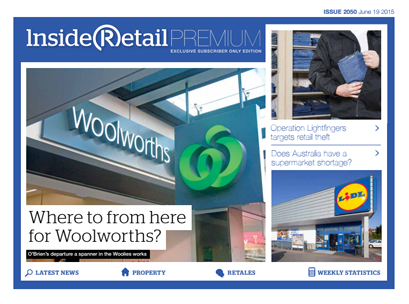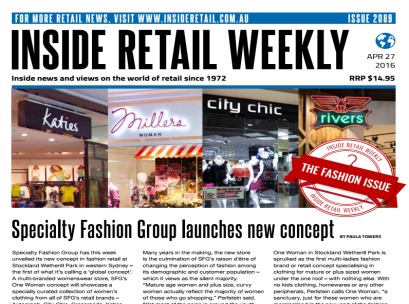Not quite time to stop the press
In this guest post, Nati Harpaz argues that print is far from dead and remains a viable profit and engagement platform as long as you are prepared to adapt your model.
 The struggle faced by traditional print publications such as newspapers is well documented as the industry faces increasing competition from the online world.
The struggle faced by traditional print publications such as newspapers is well documented as the industry faces increasing competition from the online world.
In fact, just recently, this discussion was reignited after Fairfax’s chief executive, Greg Hywood, commented to investors that the company was willing to cut print editions of major mastheads, if publishing profit continued to spiral.
As my company, Octomedia found out, moving to an online-only platform is not always smooth sailing but is also fraught with danger.
Several years ago, due to continuing increases in printing and postage costs, we decided to cancel the print edition of our long-standing publication Inside Retail Weekly, which has been in publication since 1972.
The rationale behind the decision was it would have a great impact on savings in print and postage costs if we were to only distribute a digital version of the magazine. In the 21st century, our audience expects that anyway.
You can probably guess what the outcome of this decision was…several years of significant decline in subscription levels, not exactly what we had in mind. In turn, it also proved extremely costly.
As our subscriber base continued to decline, so did our advertising revenue. Last year, we reassessed our decision to go online only and decided we needed to go back to where we came from, and we relaunched our weekly print edition of Inside Retail Weekly in October, 2015.
The result has been a significant increase to our subscription product, advertising revenue and the welcome return of our loyal readers.
By going through this transformational process, we’ve discovered asking your audience to pay a relatively high fee for a digital product is destined to fail.
So why are our readers willing to pay for a print product more than they are willing to pay for a digital product?
In a world surrounded with thousands of content pieces published on a daily basis, it is hard to convince your audience why they should be paying for content online even if the content is valuable.
In my view, the main reason for this is perceived value. A print product has tangible value. The consumer sees a physical product. It is easy to attach a value to the print production, the postage and the work that went into putting it together.
If you are delivering a weekly publication in a digital format you will most likely prompt your subscriber with an email.
That email joins a list of another 100 emails received that day and so during the day’s work your subscriber is probably putting it aside thinking they will get back to it when they finish everything else but the reality is that work really never ends and so your subscriber may forget going back to reading it.
After a while comes a renewal form and your subscriber now thinks that it’s not worth the money as he hasn’t really been reading it lately.
With a print product the subscriber gets a publication delivered right into their hands. It gives them an opportunity to take a break from the screen, sit down and relax, whilst getting up to date with industry news.
Furthermore, the publication can be taken with them whilst moving around on public transport, flights or between meetings. It is also much easier to pass around the office.
 So what does this mean for advertisers?
So what does this mean for advertisers?
I have to admit, it is a lot harder to sell print advertising compared with digital advertising. Print is different from online and it has to be sold differently.
The value of print advertising is significant and not only can it stand on its own feet it actually supports online advertising as part of an overall campaign strategy.
If you go back and read the reasons why readers like print magazines and newspapers, these reasons are also applicable to advertising. Increasing competition over advertising space makes digital advertising almost unnoticeable and companies are paying for advertising nobody sees.
Print advertising is strong, colourful and cannot be missed. It leaves a longer lasting memorable experience and supports the brand message and prestige.
The print versus digital advertising argument was again put under the microscope in a 2015 study by Canada Post and Nueromarketing firm TrueImpact.
The study used eye-tracking, EEG brain wave measurement and conventional questionnaires to compare the effects of paper marketing (in this case direct marketing) with digital media.
The study found paper marketing was easier to process mentally, taking 21% less cognitive effort to process than digital media and tested better for brand awareness, with recall 70% higher among participants who were exposed to paper marketing over digital.
So what does all this mean advertisers? Should they throw their digital strategy out the window?
Of course not. What this shows is the need for print publications to better explain the advantages of print marketing to their potential advertisers and show the value it holds within the marketing mix.
Our B2B strategy is to continue building publications which are based on a print and digital mix and we see this as the way forward. Brands and advertisers need to design their marketing plans the same way, with a complementary mix between print and digital, to ensure they reach and engage with their maximum potential audience.
Nati Harpaz is the managing director of Octomedia, publisher of Inside Retail in Australia, New Zealand, Asia and Hong Kong





Nati, you’ve pretty much outlined the reasons we never abandoned print, pushed eNewsletters and went with responsive web design over the OS tail-chasing that comes with apps. In short, giving our readers as few reasons as possible to opt out.
And yet, print’s most immediate threats come not from online competition, but the health of the supporting links in the production and distribution chain.
Printing companies are not just losing magazine business to digital, but brochures, company reports, catalogues and more. and this is on top of increasing paper costs. The result is a reduction in the number printing companies, the staffing levels at those companies and, ultimately, the quality of your finished print product, something which impacts on the decision making of your advertisers.
For those of us using Print Post for distribution, Australia Post’s three price increases over the last 12 months have eaten into whatever ad rate rises we may have introduced and we now find ourselves subject to a downgrade in service (not price) where 12 months ago a magazine lodged in Sydney for a Sydney address would be delivered in 1-2 days. It is now taking a week. Such delays also impact on advertiser perception, making the promotion of time sensitive offers, exhibitions, etc., more difficult to sell.
It is high time the Federal Government opened up the postal market to more competition in the way it has in the area of telecommunications. One only has to look to the Netherlands to see how deregulation has given consumers and publishers more choice.
With a succession of price rises, diminishing quality of service, and a flailing attempt to reinvent Gmail/Internet banking, Australia Post CEO Ahmed Fahour has not only added more pressure to the business of publishing, but put his own organisation into a death spin of contraction.
There are more elements to the perfect storm facing print publishers than just competing with online content. That should be the least of your worries.
User ID not verified.
If there was a “Like”button, I’d have clicked on both Nati’s article and Phil’s comment 🙂
User ID not verified.
Print and digital are partners, not competitors.
Publishers should be serving their audience a Sunday roast – roast beef AND Yorkshire pudding not roast beef OR Yorkshire pudding.
User ID not verified.
I’m with you Trevor.
User ID not verified.
Totally agree Phil. Printing cost has made any controlled circulation a big issue. That’s why only on our highly priced subscription product the print post is still viable. Anything else it gets very difficult to get the volumes up.
I have seen a lot of publishers working around this issue by reducing circulation or finding some forms of non postal distribution but ultimately this means that the advertiser is not getting what they paid for and its a downward spiral.
User ID not verified.
print or not is no different to a persons choice of transport or movie venue. Sometimes it’s best to walk but you won’t get to Brisbane very soon. And while I often watch streaming film I love to go to the cinema for the big ones.
Publishers need to learn that it’s the content that engages. The medium is not the message, but a horses for courses thing that needs to be good.
A lot of print is being snuffed out by managements that do not focus on product. Like Fairfax.
User ID not verified.
I established Central Coast Business Review (a monthly regional business magazine fo 26 years ago and 10 years ago the Hunter Business Review).
And then the Internet arrived and so did Facebook, Linkedin, Twitter, Instagram and along with them the “gurus” who saw that all this would take over and print would be dead.
Plenty of well meaning people were giving me advice to get out of print and go digital. But I kept harking back to the surveys I do and listening to what my readers had to say. Business people are all busy people so they don’t like getting stuff sent to them by email or Facebook etc. We introduced a weekly newsletter which we kept very relevant to recent news but even now find that less than half of our subscribers read it.
Our readers all liked the hard copy and the no nonsense concise articles we provide each month that must always be relevant.
We do have a website (which we are upgrading at present) and a Facebook page but out of a circulation of 5,000 monthly our surveys show we have a readership of around 15,000 – 20,000.
We have advertisers who have been with us every month for 26 years and more than half for over 5 years. They are not interested in advertising on our website but just want us to stick to our knitting.
On the cost of distribution I agree Australia Post is red hot. But they are the only ones who can guarantee delivery even if it is a week or so late.
User ID not verified.
What a great read. Thank you Mumbrella for facilitating an informed conversation.
User ID not verified.